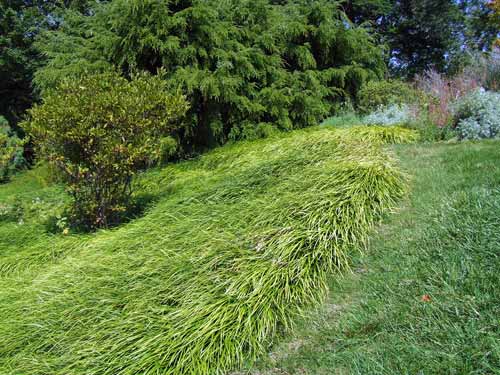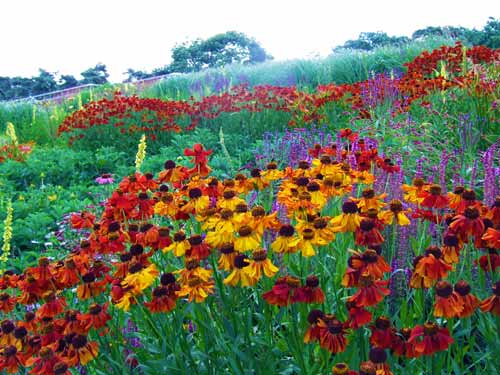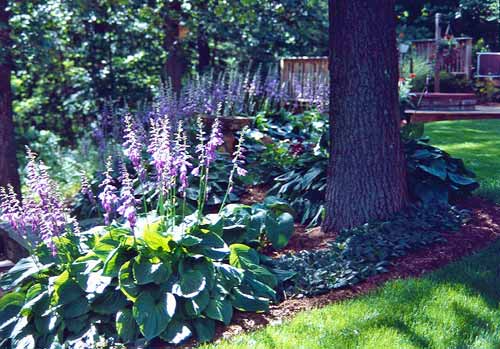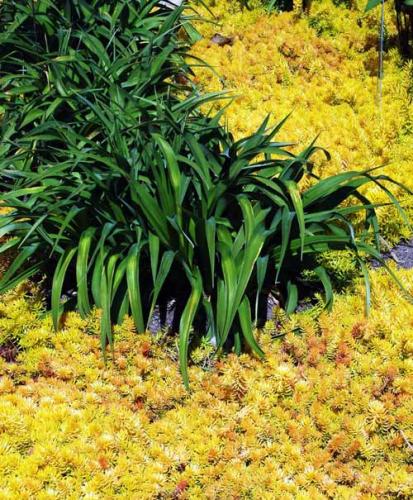Smart gardeners replace worn out turf with thrifty ground covers
Reduce overall maintenance and headaches that come with seasonal lawn die-out by planting low maintenance ground covers.
I’m sure you’ve struggled with this, too: patches in your lawn that just will not grow. Perhaps it is too shady, too wet, too dry – you know, the type of environment lawns just hate. Wouldn’t it be nice to just sit back, relax and never worry about those patches again? To fill in the gaps, perennial ground covers are taking a bigger role in home landscapes and they sure don't look like they used to.
If thinking about the traditional ground covers conjures up images of pachysandra, periwinkle (Vinca), ivy and bugleweed (Ajuga), perhaps I can help you create another mental image. Imagine these spaces in your landscape now sporting great spring or summer blooms, outstanding fall color or captivating winter character. Perhaps these spaces are replacing turf areas you no longer wish to mow such as a steep bank or a shady back-lot corner. Sound enticing? The use of ground covers is limited only by your imagination.

Liriope is a sturdy ground cover that is great to replace turf on a steep bank.
Photo credit: Rebecca Finneran, MSU Extension
Let’s start by thinking of the role ground covers play in the landscape. Simply stated, the plant has to cover the ground – size makes no difference. Ground covers can help prevent weeds, control erosion, bring beauty to the landscape and can be grown with very little maintenance once established. Ground covers may be woody, succulent, herbaceous or grass-like. Some may have evergreen character and some are deciduous.

Gardening with ground covers is only limited by your imagination,
as seen here on this sunny hillside covered in perennials including sneezeweed.
Photo credit: Rebecca Finneran, MSU Extension
By using a combination of plants, gardeners can weave an interesting tapestry that is both functional and natural looking. A woodland landscape covered with the fragile, white blooms of foamflower (Tiarella), contrasting with the rich purples of native phlox and coral bells (Heuchera,) will give a dark environment waves of light, color and texture. Many ground cover plants are selected for their spreading underground growth habit. This growth habit gives them the upper hand at out-competing weedy growth. Ground covers with a more clumping form such as hosta can also be planted in masses, which over time essentially accomplish the same thing.

These hostas fill a steep bank while creating a sea of purple blooms in early summer.
Photo credit: Rebecca Finneran, MSU Extension
The first rule for selecting groundcovers is matching the plant’s needs to your site and keeping the number of cultivars you choose, relatively few. Combining too many different types, the landscape will appear busy and cluttered.
Rule two takes into consideration the proper use of coarse- and fine-textured plants. Large-leaved plants such as pigsqueak (Bergenia) and wild ginger (Asarum canadense) are more effective when combined with fine-textured plants such as Astilbe or ferns.
Try to choose plants that will comfortably coexist with each other. For instance, two surface rooting perennial ground covers will compete with each other, but if one is deeply rooted, taking advantage of moisture and nutrients, while the other plant’s roots are shallow, allowing it to intercept brief rain showers, they can happily co-mingle. Similarly, if you combine a ground cover species such as goutweed (Aegopodium podagraria 'Variegatum') or English ivy (Hedera helix) with a non-aggressive plant such as dwarf astilbe, the weaker of the two will be completely over run.

Sedum ‘Angelina’ is a great ground-hugging contrast to these daylilies.
Photo credit: Rebecca Finneran, MSU Extension
Ready, set, grow!
For the first year of establishment, most ground covers will benefit from being watered on a regular basis unless there is ample rainfall. To avoid disease invasion, water during daytime hours when the foliage will dry off quickly. Michigan State University Extension recommends fertilizing at planting time using a slow-release fertilizer to avoid burning new tissue and provide small amounts of nutrient just when the plant needs it. Keep in mind that most ground covers have lower nutrient requirements than turf. Your lawn can require 3 to 4 pounds of nitrogen during the growing season while most perennial ground covers only need 1 pound.
Just think of the advantages of using a perennial ground cover in your landscape; simple maintenance, less lawn to mow and more time to spend shopping for plants!
For more information on a wide variety of smart gardening articles, or to find out about smart gardening classes and events, visit www.migarden.msu.edu and Finneran’s blog. You can contact the MSU Master Gardener Lawn and Garden Hotline at 888-678-3464 with your questions.



 Print
Print Email
Email




